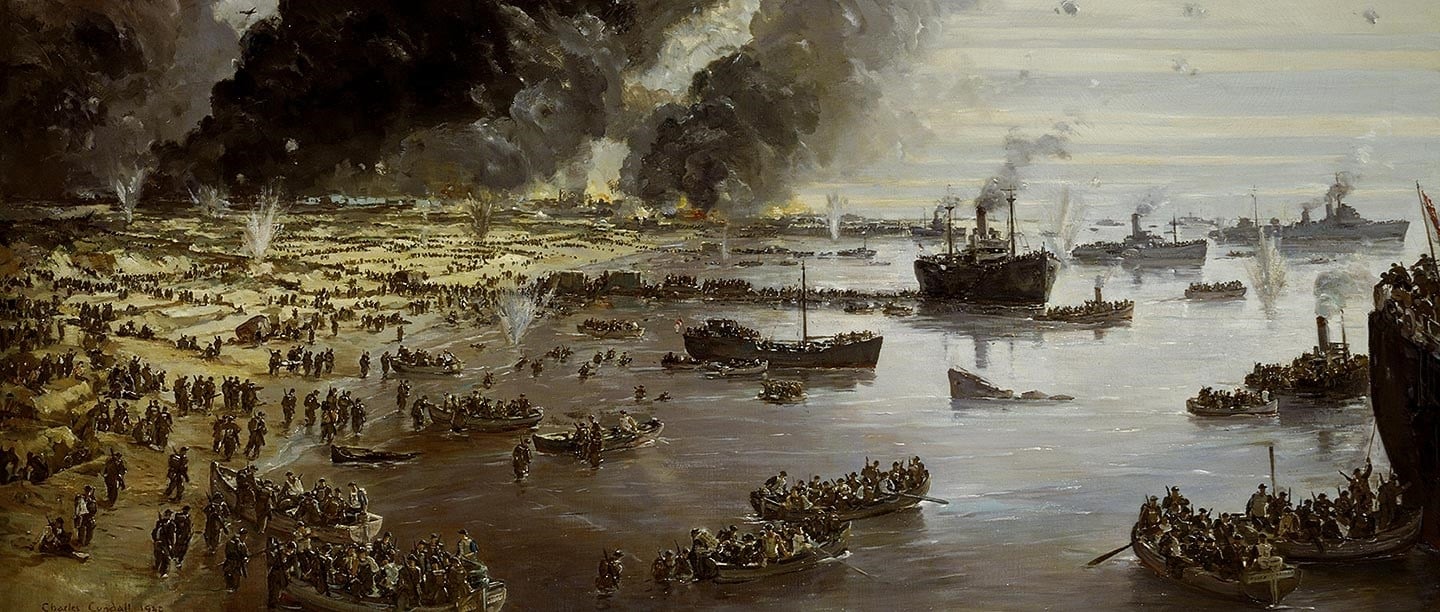Why were the Allies at Dunkirk?
The Second World War had begun in western Europe on 1 September 1939, when Germany invaded Poland. In Belgium and France there was a long winter of waiting as German and Allied forces, including the British Expeditionary Force (BEF), faced each other along the border defences.
Then on 10 May 1940, two German armies moved eastward. A smaller one swept through Holland and Belgium into northern France, drawing the main Allied forces north to meet it. The other, main German force advanced through Luxembourg, broke through the French lines at Sedan, and sliced across northern France to the coast. Moving rapidly with armoured columns, these armies trapped the Allies in an ever-decreasing pocket.
The Germans took Boulogne on 25 May and Calais the next day, leaving Dunkirk as the only viable port from which the BEF, part of the French army and the remains of the Belgian army could escape.
What was Operation Dynamo?
Operation Dynamo was the rescue operation implemented by the Royal Navy. It was co-ordinated by Vice Admiral Bertram Ramsay and his small team in Dover Castle. There, beneath the fortress, a network of tunnels deep within the cliffs became the nerve centre controlling the evacuation of Allied forces.
From 19 May, realising that rescue by sea would be necessary, Ramsay and his staff at Dover were making plans and arranging for ships to evacuate the BEF. On 26 May they were ordered to put their plans into action.
Find out more about Dover Castle’s History
Why was it called Operation Dynamo?
It’s sometimes stated that Operation Dynamo took its name from a room in the Dover Castle tunnels which had once held a dynamo – a machine that generated electricity. However, there’s no evidence for this. Dynamo was just a code word.
The tunnels below the castle, which were first dug during the Napoleonic wars, continued to play a vital role in the war effort after Dunkirk. From 1943 they served as a combined headquarters for all three services – army, navy and air force.
Visit Dover CastleWhy was evacuation from Dunkirk so difficult?
The Allies had to defend a small pocket around Dunkirk that was under constant attack. Many thousands of men were crammed into streets and buildings, and along the beaches – so they were very vulnerable to intense German air attacks and shelling. There was little time to plan and organise an orderly evacuation, and effective means of communication were scarce.
The Germans had put the main docks at Dunkirk – the best place from which to evacuate troops – out of action. The two alternatives – the spindly breakwater, or mole, on the east side of the harbour, and the beaches to the north of the port – were far from ideal. The beaches at Dunkirk shelve gently into the sea. Even at high tide, a destroyer couldn’t approach within a mile of the shore, and troops had to be ferried out in small craft.
Rescue was painfully slow at first – only 8,000 men were rescued on the first day. It took several days for the operation to gather pace.
What did the ‘Little Ships’ do during the evacuation from Dunkirk?
The little ships played an important part in the evacuation. Ramsay and his team quickly realised that small boats would be able to get close to the beach and ferry the troops out to larger ships. By 31 May, hundreds of civilian vessels – from fishing smacks and cockle boats to lifeboats and sailing barges – had answered the Royal Navy’s call for help and crossed the English Channel to Dunkirk.
Crewed mainly by volunteers, these tiny vessels bravely and repeatedly picked up soldiers queuing patiently on the beaches and in the water, and ferried them out to the waiting larger ships, under severe attack from German aircraft and artillery. Many also took troops back across the Channel themselves.
But it’s a common misconception that the little ships evacuated most of the men. In fact, over two-thirds (239,465) reached safety via the mole, while 98,761 were rescued from the beaches. And the role of the Royal Navy, especially its destroyers, was paramount in the operation. Its ‘big ships’ – mainly destroyers, minesweepers and requisitioned merchant vessels with naval crews – crossed to Dunkirk time and time again, without rest, and suffered terrible losses.
Operation Dynamo: Key Numbers
- Dates: 26 May – 4 June 1940
- Number of troops rescued: 338,226 including 224,320 British
- Ships involved: 933
- Ships lost: 236
Was the Dunkirk Evacuation a Disaster or a Triumph?
Dunkirk, and the surrender of France that followed some three weeks later, left Britain isolated, vulnerable and under threat of imminent invasion. The BEF had abandoned or destroyed nearly all its heavy equipment at Dunkirk. Hitler declared the evacuation a decisive victory for Germany.
But by rescuing the bulk of the army, in what was the biggest evacuation in military history, Operation Dynamo returned to Britain a priceless asset – most of her trained and experienced troops. If they had been lost, the whole conflict might have taken a very different course. It was a critical moment for Britain in the Second World War.
‘We must be very careful not to assign to this deliverance the attributes of a victory. Wars are not won by evacuations.’ Winston Churchill, 4 June 1940
What was the ‘Dunkirk Miracle’?
The evacuation was publicised as a miracle to boost public morale. The successful rescue, across seas that stayed unusually calm for nine days, was thereafter referred to as ‘the miracle of Dunkirk’.
But as well as this, the terrifying prospect that the depleted British armed forces might have to fight the Germans on home soil caused the nation, galvanised under Winston Churchill, to devote itself entirely to war. It did so not only effectively but, perhaps surprisingly, with total confidence in eventual victory. The ‘Dunkirk spirit’, reflecting a nation united and working against apparently impossible odds to thwart Hitler’s ambitions, was born.
Top image: The Withdrawal from Dunkirk by Charles Ernest Cundall, June 1940 (© IWM via Getty Images)
A Veteran’s Story
Between 1939 and 1942 former Army Signalman Richard Sheen served at Dover, where he used radar to plot enemy aircraft crossing the Channel, and communicated their positions to anti-aircraft batteries along the coast. In this interview he reveals what life was like in Dover’s Gun Control Room and his experiences of helping the rescued soldiers off the ships.
All archive footage supplied by Huntley Film Archives Ltd.
Find out more
-
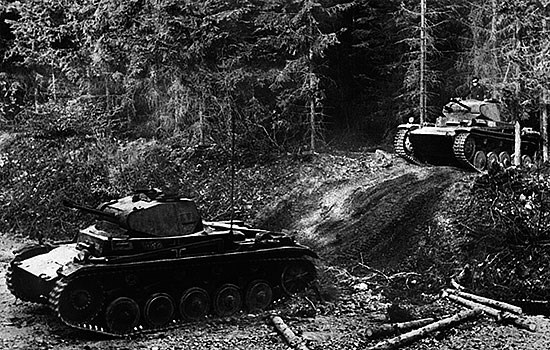
The Fall of France in 1940
On 22 June 1940 the French government surrendered to Hitler, just six weeks after the Germans’ initial advance westwards. Find out why France collapsed so quickly.
-
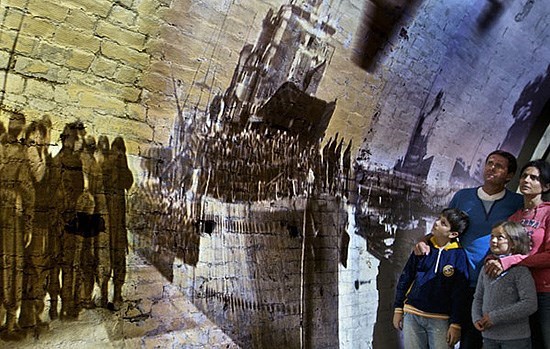
Operation Dynamo and the Dover Tunnels
Find out how you can immerse yourself in the drama of the Dunkirk evacuation, in the very tunnels where Operation Dynamo was masterminded.
-
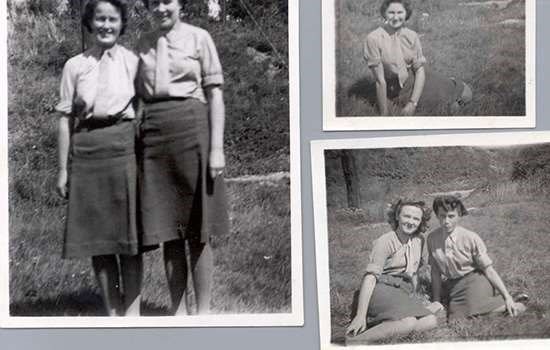
Dunkirk on the Home Front
Read some of the personal stories of what it was like to work in the tunnels beneath Dover Castle in the gruelling, hot days of May and June 1940.
-
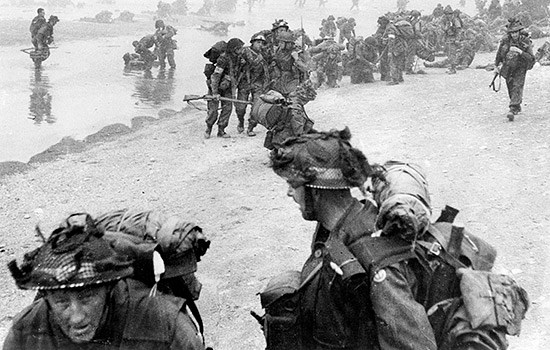
D-Day Deception: Operation Fortitude South
In 1944, Dover Castle’s tunnels played a supporting role in an elaborate deception that concealed the true location of the D-Day landings from the Germans.
-
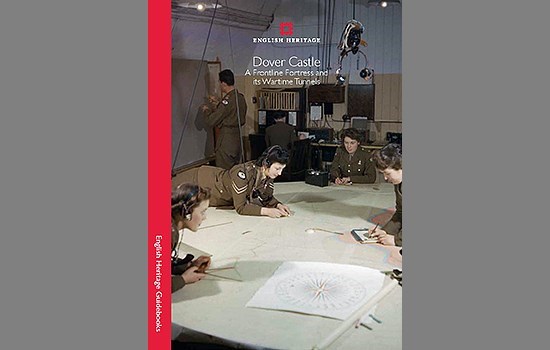
Dover on the Front Line
This guidebook tells the story of how a network of tunnels beneath Dover Castle played a vital role in the Second World War.
-
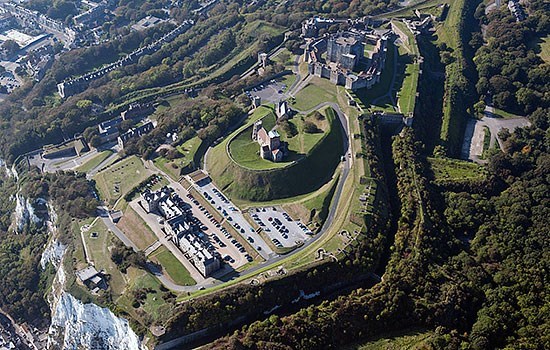
History of Dover Castle
Discover the castle’s long history, from its likely origins as an Iron Age hillfort, through its development as a great fortress, to its secret role in the Cold War.

